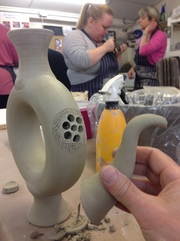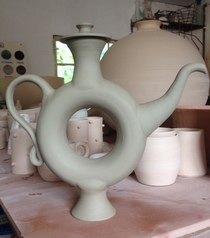Making Process for a Stoneware or Porcelain Teapot.
The making of a porcelain teapot could happen like this:
- The clay is prepared to the right recipe and water content for making and is wedged and kneaded to ensure an even and homogeneous consistency.
- The pot is thrown on the wheel plus the lid and spout. Sometimes the shape may be modified and the surface may be textured at this stage. Many people think that throwing is the only skill of the potter however there is a lot more to follow:
- Wait a few days for parts of the teapot to become firm or ‘leather hard’.
- A handle is made.
- Excess clay is trimmed off to make the teapot thin and delicate.
- The shape is modified if required.
- The lid, spout and handle are fitted.
- Slips and underglazes may be applied for colour and texture effects
- Wait a few more days to completely dry.
- The teapot is ‘bisque-fired’ to 950 C or orange-hot in the kiln. A slow warm up removes the last drops of water. The tiniest amount of remaining water in the clay body at 100 C will cause the pot to explode into hundreds of pieces. Between 300 and 800 C the fire burns out any organic matter and removes chemically combined water. At about 900 C clay particles begin to ‘sinter’ or stick together making the clay body hard and porous for glazing. At 950 C the kiln is cooled and the pots come out porous and brittle ready for glazing. The firing cyle typically takes 24 hours.
- Underglazes, decorations and glazes are applied to the surface.
- The teapot is glaze-fired to 1260 C or nearly white-hot. At top temperature the pot is quite soft and molten. The firing vitrifies the clay body; this means the clay particles fuse together and the pot shrinks considerably. The firing also melts and matures the glaze particles so they run and stick to each other and become glassy. As the pot slowly cools it becomes really hard and impervious to water; it stops glowing and reveals the final glaze texture and colour. When the temperature falls to about 200 C or domestic oven temperature, the kiln can be cooled more quickly.
- Did you know that a porcelain pot typically shrinks by 20% between the wet clay and fully fired stages? Stoneware typically shrinks by 13%.


